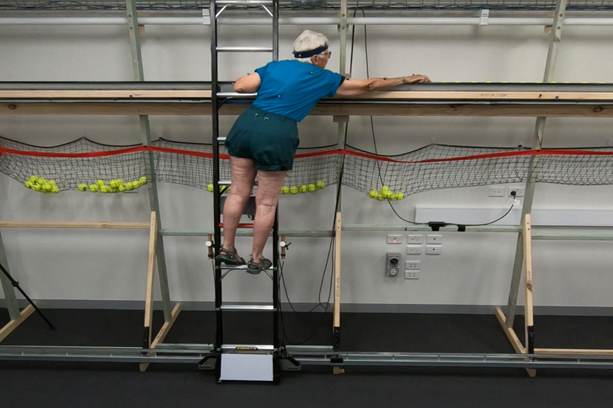By Dr Erika Pliner
Ladder use is a hazardous activity and the leading cause of fatal falls from a height. Older adults are at highest risk of experiencing a ladder fall during household activities, such as clearing a roof gutter. Climbing (foot and body position, handhold force) and environmental (climb direction, ladder angle) factors are known to affect ladder fall risk, but little is known about individual characteristics that may predispose someone to a ladder fall. Therefore, we conducted a study to determine individual factors that contribute to effective ladder use.
We recruited 100 older adults and asked them to clear a gutter using a straight ladder in the laboratory (Figure 1). The gutter was 2.1 m above the ground, 5.8 m in length, and filled with tennis balls. The straight ladder was partially fixed to the experimental setup that supported the gutter, simulating a straight ladder leaning against a wall. The ladder was easily moved laterally along the wall to the desired location. To completely clear the length of the gutter, participants had to move and climb the ladder multiple times. We recorded time to complete this task as the outcome measure.
For each participant, we assessed individual metrics of strength, upper limb control, balance, cognition, and propensity for risk-taking. To determine which individual factors are related to effective ladder use, we performed regression analysis with the individual metrics on task completion time. Our results showed that the time taken to clear the gutter was predicted by multiple individual factors. Specifically, participants with greater quadriceps strength, better upper limb coordination, more controlled leaning balance, and a greater propensity for taking risks completed the gutter clearing task faster, suggesting these participants to be more effective ladder users.
Knowledge of individual factors that are associated with effective ladder use can be used to direct ladder fall interventions. Ladder users who take longer to complete ladder tasks (increasing their ladder use exposure and fall risk) may be identified and warned of their fall risk through screening tools and targeted for strength and balance training interventions to reduce their fall risk. Further, this knowledge can guide ladder design and safety instruction. Specifically, ladders could be designed to reduce the need for superior balance control and quadriceps strength with a greater base-of-support at lower rungs commonly used for working heights. Safety instructions may be updated to inform users to utilize additional tools to avoid strenuous postures that require greater upper limb coordination. Future work is needed to assess the trade-off between efficient ladder use (faster task completion times) and risky ladder use (completing the task near or outside stability limits).

Figure 1. Experimental set-up
Pliner, E.M., Sturnieks, D.L., Lord, S.R. (2020). Individual factors that influence task performance on a straight ladder in older people. Experimental Gerontology, 142: 111127. https://doi.org/10.1016/j.exger.2020.111127
About the Author

Erika Pliner
Department of Aging and Geriatric Research, University of Florida
Erika’s expertise is in falls, biomechanics, and human factors & ergonomics. Her postdoctoral training is advancing her knowledge in aging, neuromechanics and mobile brain imaging via EEG. Her current research aims to quantify the efficacy of balance training paradigms by manipulating sensory information and measuring electrocortical and biomechanical responses.
Copyright
© 2021 by the author. Except as otherwise noted, the ISPGR blog, including its text and figures, is licensed under a Creative Commons Attribution-ShareAlike 4.0 International License. To view a copy of this license, visit https://creativecommons.org/licenses/by-sa/4.0/legalcode.
ISPGR blog (ISSN 2561-4703)
Are you interested in writing a blog post for the ISPGR website? If so, please email the ISGPR Secretariat with the following information:
- First and Last Name
- Institution/Affiliation
- Paper you will be referencing


